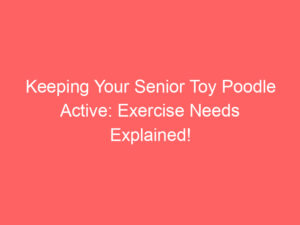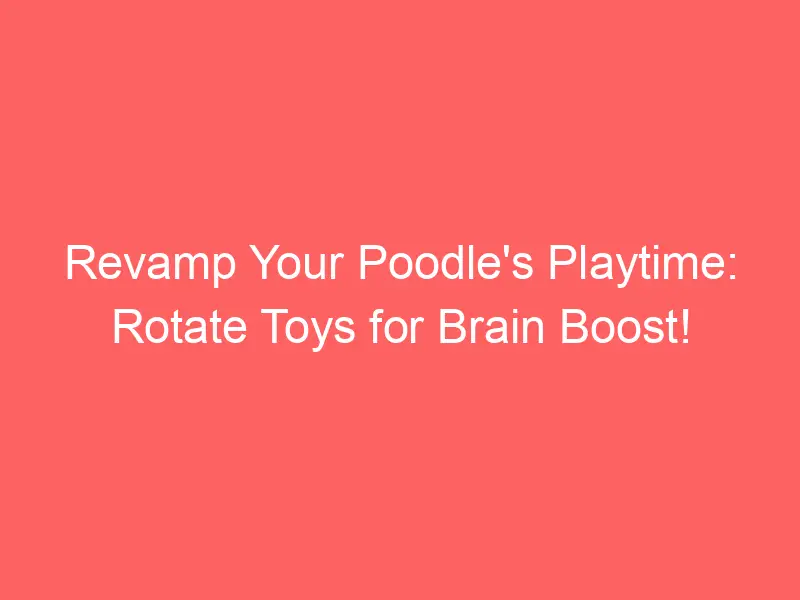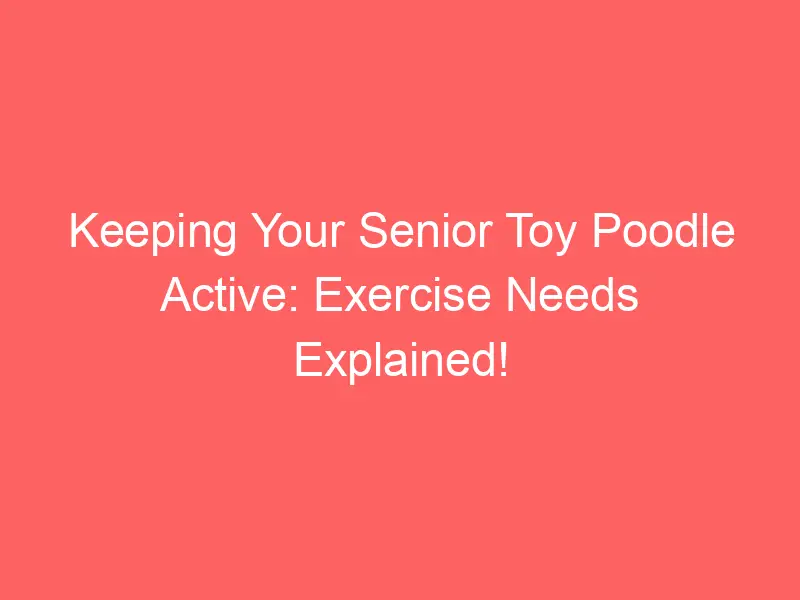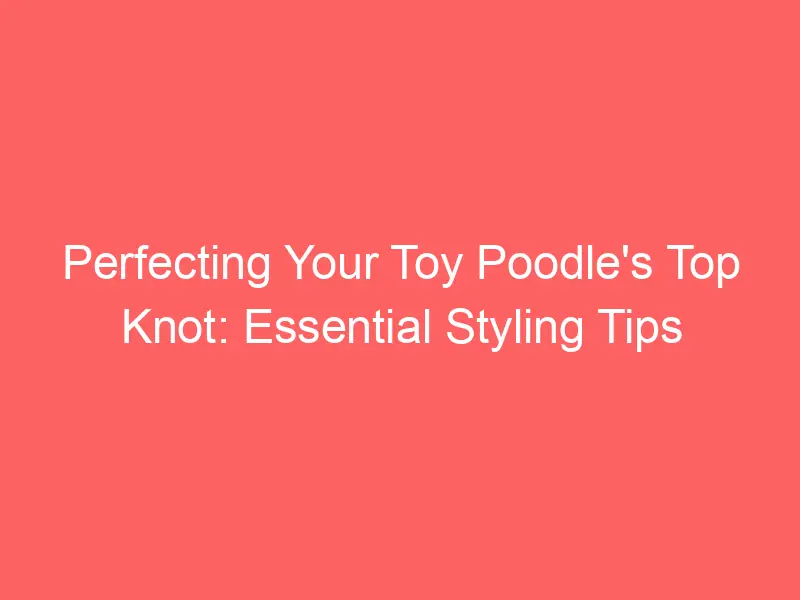Understanding Toy Poodle Exercise Requirements

Toy Poodles, despite their small size, are active dogs that require regular exercise to maintain their health and happiness. Understanding their unique exercise needs is crucial for any Toy Poodle owner. In this section, we will explore why regular exercise is important for Toy Poodles, the physical and mental benefits it provides, and how to cater to their specific exercise needs.
-
- Importance of Regular Exercise for Toy Poodles
Toy Poodles are energetic and intelligent dogs. Regular exercise helps them burn off their energy and keeps them physically fit. Without enough exercise, they can become bored and may develop destructive behaviors. Exercise also helps maintain their weight, reducing the risk of obesity-related health issues. According to a Wikipedia article, Toy Poodles are prone to certain health conditions that can be managed or prevented with regular exercise.
-
- Physical and Mental Benefits of Exercise
Exercise provides numerous physical benefits for Toy Poodles, including improved cardiovascular health, stronger muscles and bones, and increased overall longevity. It also aids in digestion and helps maintain a healthy weight. Mentally, exercise stimulates their minds, reduces anxiety, and helps them stay alert and active. A study mentioned on Wikipedia shows that dogs who get regular exercise are less likely to develop behavioral problems.
-
- Understanding the Unique Exercise Needs of Toy Poodles
While Toy Poodles need regular exercise, their small size means they don’t require as much physical activity as larger breeds. Short, frequent walks combined with playtime and mental stimulation are usually sufficient. However, each Toy Poodle is unique, and their exercise needs can vary based on their age, health, and individual personality. Always observe your dog’s behavior and consult with your vet to determine the best exercise routine for your Toy Poodle.
In the next sections, we will delve deeper into creating a walking routine for your Toy Poodle, exploring other forms of exercise beyond walking, and understanding the health benefits of physical activity for this breed. Stay tuned!
Creating a Toy Poodle Walking Routine
Walking is a fundamental part of a Toy Poodle’s daily routine. It not only provides the necessary physical exercise but also stimulates their mind and satisfies their instinct to explore. Here’s how you can establish an effective walking routine for your Toy Poodle.
Establishing a Routine
Creating a walking routine for your Toy Poodle involves three key steps:
-
- Choosing the right time for walks
Toy Poodles are adaptable and can adjust to your schedule. However, it’s generally recommended to walk them during cooler parts of the day, such as early morning or late evening, to prevent overheating. Remember, the goal is to make the walk enjoyable and safe for your pet.
-
- Consistency in the walking routine
Consistency is key when establishing a walking routine. Try to walk your Toy Poodle at the same times each day. This consistency helps your pet understand what to expect and can also aid in house training.
-
- Adjusting the routine as per your Toy Poodle’s needs
Every Toy Poodle is unique, and their walking needs may vary based on their age, health, and energy level. Puppies and younger dogs generally require more frequent walks or play sessions throughout the day, while older dogs may prefer shorter, more leisurely strolls. Always monitor your pet during walks and adjust the routine as needed to ensure they’re getting the right amount of exercise without overexertion.
In conclusion, establishing a walking routine for your Toy Poodle requires careful consideration of the best times to walk, maintaining consistency, and adjusting the routine as per your pet’s needs. A well-planned walking routine can contribute significantly to your Toy Poodle’s overall health and happiness.
Walking a Toy Poodle: Key Points
-
- Proper Leash Training
Leash training is an essential part of walking your Toy Poodle. It is important to ensure that your dog is comfortable with the leash and understands how to behave when on it. Start by introducing the leash in a calm environment and gradually increase the distractions as your dog becomes more comfortable. Remember, patience and consistency are key in this process. For more detailed information on leash training, you can visit Wikipedia’s page on Dog Training.
-
- Understanding Your Toy Poodle’s Walking Pace
Toy Poodles are small dogs with a fast metabolism, which means they can walk at a brisk pace. However, it’s important not to push them too hard, as this can lead to exhaustion or injury. Pay attention to your dog’s body language during walks. If they seem tired or are lagging behind, it might be time to take a break. Remember, walking should be an enjoyable experience for both you and your Toy Poodle.
-
- Ensuring Safety During Walks
Safety should always be a priority when walking your Toy Poodle. Always keep your dog on a leash to prevent them from running into traffic or getting lost. Be aware of your surroundings and avoid areas with aggressive dogs or heavy traffic. Also, make sure your Toy Poodle is up-to-date on vaccinations and flea and tick prevention to protect them from diseases. For more tips on dog safety, you can check out Wikipedia’s page on Dog Safety.
Toy Poodle Daily Exercise: Beyond Walking
While walking is an essential part of a Toy Poodle’s exercise routine, it’s not the only way to keep your furry friend active and healthy. There are plenty of other activities that can provide both physical and mental stimulation for your Toy Poodle. Let’s explore some indoor exercises that can be beneficial for your pet.
Indoor Exercises
Indoor exercises are a great way to keep your Toy Poodle active, especially during inclement weather or when outdoor activities are not feasible. Here are a few ideas:
- Interactive toys for mental stimulation: Interactive toys are not just fun for your Toy Poodle, they also provide mental stimulation. Toys like puzzle feeders or treat-dispensing toys can keep your pet engaged and mentally sharp. According to a Wikipedia article, interactive toys can help reduce boredom and destructive behaviors in dogs.
- Indoor games that promote physical activity: Games like hide and seek, fetch, or tug-of-war can be played indoors and are excellent for keeping your Toy Poodle physically active. These games not only provide physical exercise but also help in building a strong bond between you and your pet.
Remember, the key is to keep the activities varied and fun for your Toy Poodle. This will ensure that your pet remains interested and looks forward to the exercise sessions. Always supervise your pet during these activities to ensure their safety.
Outdoor Exercises
Outdoor exercises are a great way to keep your Toy Poodle active and healthy. They not only provide physical exercise but also give your dog a chance to explore the outside world. Here are some outdoor exercises that you can try with your Toy Poodle:
-
- Playing Fetch
Playing fetch is a classic outdoor exercise that dogs love. It’s simple, fun, and provides a great workout for your Toy Poodle. All you need is a ball or a toy that your dog likes. Throw it, and your dog will run to get it and bring it back to you. This game is not only good for your dog’s physical health but also helps improve their focus and obedience.
-
- Agility Training
Agility training is a fantastic way to keep your Toy Poodle physically and mentally stimulated. In agility training, dogs navigate through a course with various obstacles under the guidance of their owner. This exercise helps improve your dog’s coordination, speed, and obedience. You can set up a simple agility course in your backyard using items like tunnels, ramps, and jumps. Remember to always keep the training fun and positive for your dog.
-
- Swimming: A Great Exercise for Toy Poodles
Swimming is an excellent exercise for Toy Poodles. It’s a low-impact exercise that’s easy on their joints, making it a great option for older dogs or dogs with joint issues. Plus, most dogs love water! If you have access to a safe body of water, consider taking your Toy Poodle for a swim. Always supervise your dog while they’re in the water, and consider using a doggy life jacket for extra safety.
Remember, every dog is unique, and what works for one might not work for another. It’s important to try different exercises and see what your Toy Poodle enjoys the most. Always keep safety in mind and make sure your dog is having fun!
Physical Activity for Toy Poodles: Health Benefits
Physical activity is not just a way to keep your toy poodle entertained, it also provides numerous health benefits. Regular exercise can help prevent obesity, improve cardiovascular health, and enhance mental health while reducing anxiety. Let’s delve into these benefits in more detail:
- Prevention of Obesity: Regular physical activity helps maintain a healthy weight in toy poodles. Obesity in dogs can lead to a variety of health issues, including diabetes, heart disease, and joint problems. According to a Wikipedia article, approximately 25% to 30% of the general canine population is obese, with rates significantly increasing in dogs that are middle-aged and older. Regular exercise can help keep your toy poodle within a healthy weight range.
- Improved Cardiovascular Health: Just like in humans, exercise improves heart health in dogs. Regular physical activity strengthens the heart muscle, reduces blood pressure, and helps regulate blood sugar levels. A strong heart can pump blood more efficiently, providing oxygen and nutrients to your toy poodle’s body more effectively.
- Enhanced Mental Health and Reduced Anxiety: Exercise is a natural stress reliever for dogs. It helps release pent-up energy and reduces symptoms of anxiety. Regular physical activity can also stimulate your toy poodle’s mind, helping to prevent cognitive disorders and improve overall mental health. A study mentioned in a Wikipedia article on dog health suggests that dogs who engage in plenty of physical activity are less likely to develop behavioral problems.
As you can see, regular physical activity is crucial for the overall health and well-being of your toy poodle. It helps prevent obesity, improves cardiovascular health, and enhances mental health. So, make sure to incorporate a good mix of physical activities in your toy poodle’s daily routine.
Toy Poodle Care Guide: Exercise and Diet
Ensuring your Toy Poodle’s health and happiness requires a balanced approach to both exercise and diet. This guide will provide you with essential tips and insights to help you make the best choices for your furry friend.
Exercise and Nutrition: A Balanced Approach
Just like humans, dogs need a combination of regular physical activity and a nutritious diet to stay healthy. The balance between these two elements is particularly crucial for Toy Poodles, who are known for their energetic nature and specific dietary needs.
-
- Importance of a balanced diet in conjunction with regular exercise
Regular exercise helps your Toy Poodle maintain a healthy weight and muscle tone, while a balanced diet provides the nutrients necessary for energy, growth, and overall health. According to the American Kennel Club, dogs who are both well-exercised and well-fed tend to have stronger immune systems, healthier coats, and better digestive health.
-
- Choosing the right food for your active Toy Poodle
When it comes to feeding your Toy Poodle, quality is key. Look for dog food that is high in protein to support muscle health, with a good balance of carbohydrates for energy. Avoid foods with artificial additives and fillers. Instead, opt for natural ingredients that provide essential vitamins and minerals. Remember, every dog is unique, so it’s important to consult with your vet to determine the best diet for your Toy Poodle.
In conclusion, a balanced approach to exercise and diet is essential in caring for your Toy Poodle. By providing regular physical activity and a nutritious diet, you can help ensure your furry friend lives a long, healthy, and happy life.
Toy Poodle Health and Exercise: Common Concerns
When it comes to keeping your Toy Poodle healthy and happy, exercise plays a crucial role. However, both over-exercising and under-exercising can pose risks to your furry friend’s wellbeing. Let’s delve into these common concerns and how to address them.
-
- Over-exercising your Toy Poodle: Signs and prevention
Over-exercising a Toy Poodle can lead to exhaustion, injury, and long-term health problems. Signs that your Toy Poodle may be over-exercised include excessive panting, limping, loss of appetite, and lethargy. To prevent over-exercising, it’s important to monitor your dog’s behavior during and after exercise. If your dog shows any signs of distress, it’s time to take a break. Additionally, consult with your vet to establish an appropriate exercise routine for your Toy Poodle’s age, size, and health condition.
-
- Under-exercising your Toy Poodle: Risks and signs
On the other hand, under-exercising your Toy Poodle can lead to obesity, heart disease, and behavioral issues such as excessive barking or chewing. Signs that your Toy Poodle may not be getting enough exercise include weight gain, restlessness, and destructive behavior. To ensure your Toy Poodle gets enough exercise, aim for at least 30 minutes of physical activity per day. This can include walks, playtime, or even training sessions. Again, your vet can provide personalized advice based on your dog’s individual needs.
In conclusion, maintaining a balanced exercise routine is key to your Toy Poodle’s health and happiness. By being mindful of the signs of over-exercising and under-exercising, you can ensure your furry friend stays fit and content.
Toy Poodle Walking Tips
Walking your Toy Poodle is an essential part of their daily routine. It not only provides them with the necessary exercise, but it also stimulates their mind and allows them to explore their environment. However, walking your Toy Poodle can be a bit more challenging in different weather conditions. Here are some tips to help you navigate through these situations.
Walking in Different Weather Conditions
Toy Poodles are adaptable and can handle a variety of weather conditions, but it’s important to take certain precautions to ensure their safety and comfort. Here are some tips for walking your Toy Poodle in hot and cold weather.
-
- Walking your Toy Poodle in hot weather: Precautions and tips
During hot weather, it’s best to walk your Toy Poodle early in the morning or late in the evening when temperatures are cooler. Always bring water for both you and your dog to prevent dehydration. Be mindful of hot pavement, which can burn your dog’s paws. Consider using protective dog booties or paw wax to protect their feet. If your dog shows signs of overheating, such as excessive panting, drooling, or lethargy, stop the walk and seek immediate veterinary care.
-
- Walking your Toy Poodle in cold weather: What to know
In cold weather, your Toy Poodle may need a doggy sweater or coat to stay warm during walks. Be mindful of ice and snow, which can be slippery and pose a risk for injury. Also, be aware of the risk of frostbite and hypothermia, especially if your dog is wet or in the cold for an extended period. After the walk, check your dog’s paws for ice balls and wipe them down to remove any de-icing chemicals that could be harmful if ingested.
Walking your Toy Poodle in different weather conditions can be a rewarding experience if done safely. Always monitor your dog’s comfort and health, and adjust your walking routine as necessary to accommodate the weather conditions.
Creating a Toy Poodle Exercise Plan: A Step-by-Step Guide
Creating an exercise plan for your Toy Poodle is an essential part of ensuring their health and happiness. This guide will walk you through the process step-by-step.
-
- Assessing your Toy Poodle’s current activity level
Before you can create an effective exercise plan, you need to understand your Toy Poodle’s current activity level. Spend a few days observing your dog’s behavior. Note how much time they spend running, playing, and walking each day. This will give you a baseline to work from when setting exercise goals.
-
- Setting realistic exercise goals
Once you have a clear picture of your Toy Poodle’s current activity level, you can start setting exercise goals. Remember, these goals should be realistic. If your dog is currently only active for 30 minutes a day, it’s not realistic to expect them to suddenly start exercising for two hours every day. A more realistic goal might be to gradually increase their activity level to 45 minutes or an hour a day.
-
- Creating a diverse and engaging exercise routine
Toy Poodles are intelligent dogs that thrive on variety and mental stimulation. Try to create a diverse exercise routine that includes different types of activities. This could include walks, playtime with toys, and even training sessions that work their brain as well as their body. Remember to keep the exercise sessions fun and engaging for your dog.
-
- Monitoring progress and adjusting the plan as needed
Once you’ve set your exercise goals and created a routine, it’s important to monitor your dog’s progress. Keep an eye on their energy levels, weight, and overall health. If you notice any negative changes, it may be a sign that the exercise plan is too strenuous and needs to be adjusted. Remember, the goal is to improve your dog’s health and happiness, not to push them to their limits.
In conclusion, creating an exercise plan for your Toy Poodle is a process that requires careful observation, realistic goal-setting, and ongoing monitoring. But with patience and dedication, you can help your furry friend lead a healthier and more active life.














